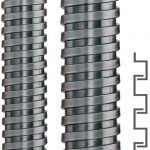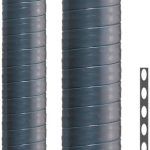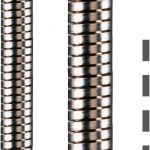
Conduits — any tube or trough that encases wires — protect against strain and wear from the elements. Electricians may want to stuff conduits, but overfilling can lead to unsafe installation. When running electrical cables and wires, it is essential to calculate the appropriate conduit fill to prevent conductor damage and meet national safety standards.
Requirements for conduit fill can be complicated, yet following them is essential for preventing costly rewiring and unsafe conditions. Learn how to calculate conduit fill and why it is important in this guide.
Table of Contents
Conduit and Conductor Materials
Correctly determining conduit fill requires knowledge of the conduit and conductor materials you should use for your specific application. Different materials work optimally in various settings, so you must select the best conduit and cable materials for your job. The most common conduit materials include:
- HDPE: High-density polyethylene (HDPE) is a versatile plastic popular for forming conduits in houses and protecting electrical and telecommunications cables. This material is highly resistant to UV damage, corrosion and chemicals.
- Nylon: Nylon is oil, abrasion and solvent resistant, with good weather protection. Molded nylon conduits are used in machine and automotive manufacturing.
- PVC-coated metal: Conduits with a metal base provide enhanced strength. PVC-coated metal conduits are typically used in machine connections and factory wiring.
You will also need to know which materials you will encounter for the cables in your conduit fill. Using the correct wires and cables will reduce the need to rewire and promote a safe installation. These are the conductor materials most often used:
- THHN: THHN is a nylon-coated wire rated for temperatures up to 194 degrees Fahrenheit in both dry and damp conditions. THHN is used in appliances, control circuits and machine tools.
- THHW: This wire is rated for 167 degrees Fahrenheit in wet conditions and 90 degrees Celsius in dry conditions. THHW is ideal for feeders, branch circuits and service entrances.
- THWN: This conductor type is rated 167 degrees Fahrenheit for dry and wet conditions. THWN is used in general wiring, controlled circuits, machine tools, etc.
- THW: THW is rated at 167 degrees Fahrenheit for dry and wet conditions. This type of conductor is used in building wiring and feeder and branch circuits.
- XHHW: This conductor is highly heat and water-resistant. XHHW is rated for 167 degrees Fahrenheit in wet applications and 194 degrees in dry and damp conditions. This material is best suited for building wiring and branch and feeder circuits.
Defining Conduit Fill
Conduit fill is the amount of a conduit’s cross-section that is filled with cables. This is calculated as a percentage of the conduit’s inside area. The allowable conduit fill based on the National Electric Code’s (NEC) guidelines is determined by the cable or wire’s outside diameter and the conduit’s inside diameter. Once you know these numbers, you can use the conduit fill calculation to determine if your installation meets safety requirements.
If you use a conduit fill calculator, you will need to consider several factors, including:
- Conduit type
- Conduit size, in diameter
- Wire or cable type
- Wire or cable size, in diameter
- The number of wires or cables
All conductors count in conduit fill. This means you must include the measurements of the grounding and bonding conductors when calculating conduit fill.
Why Calculating Conduit Fill Matters

Calculating conduit fill percentage isn’t just an additional step during electrical installations to ensure you meet requirements. Following the right fill percentage significantly impacts your installation’s safety and can save money on future installations. Here are the top reasons why following NEC conduit fill standards matters:
- It improves installation safety: When a conduit is stuffed with several large cables or wires, the heat generated is trapped inside. This generated heat must be able to dissipate through the conduit. Otherwise, excess heat will collect inside the conduit, damaging the conductors or causing a malfunction in the electrical wiring.
- It reduces costs on future installations: Over-filling conduits can also physically damage conductors during withdrawal or installation. With too many conductors inside, removing them can damage the conductor or its insulation. This effect can increase costs on later installations and cause unnecessary wear to the conductors.
Correct conduit filling ultimately prevents costly reinstallations and keeps electrical wiring safe. When conduits are correctly filled, the electrical wiring should work effectively without interference.
How to Calculate Conduit Fill
Calculating conduit fill percentage takes a few steps to save you time and make your electrical installation safer. Follow these steps for calculating conduit fill to determine how much wiring you can put in any given conduit:
1. Determine the Number of Conductors
First, identify the number of cables you want to run inside the conduit. Consider any future conductors you need to install, leaving enough wiggle room to insert those cables later on. Remember that all conductors count in this calculation, including ground wires. You also need to determine the insulation types on these wires.
2. Calculate the Wire Cross-Sectional Areas
To determine the amount of space your conductors will take up inside the conduit, calculate wire cross-sectional areas. You need to know each wire or cable’s gauge, insulation type and number within the conduit.
The equation for finding the cross-sectional areas is 0.79 times the wire’s diameter squared. The diameters of these materials and your wire’s gauge can be found in manufacturer information or the NEC book. Once you calculate the cross-sectional areas for each wire, add them together to find the total cross-sectional area in square inches.
3. Find the Conduit’s Minimum Space Available
The NEC allows certain fill percentages for one, two or more wires. These percentage guidelines reduce the likelihood of trapping heat and jamming wires and cables during withdrawal. The NEC conduit fill chart specifies these maximum conduit fill percentages:
- Maximum fill for one conductor is 53% of the space in the conduit.
- Maximum fill for two conductors is 31%.
- Maximum fill for more than two conductors is 40% of the conduit.
Use the cross-sectional areas you calculated in the previous step to determine the minimum size of conduit you can use to house your conductors. The NEC book outlines fill percentages for each type of conduit, whether EMT, IMC or GALV. Pick a conduit that is at least as large as the minimum requirement.
4. Refer to the National Electric Code (NEC)
Fortunately, the NEC also uses the conduit fill chart to reduce the number of calculations necessary. The NEC book details the correct conduit fill in a conduit fill chart located in chapter nine. This chart specifies the fill allowable for each wire gauge.
Open the NEC book to the conduit fill chart. The first column lists wire gauges, where you can find the gauge you are using. Across from the gauges on the table, look over to the maximum number of wires you can place inside a conduit of the diameter you are using. Ensure that your calculations align with the chart. If you are using wires of multiple sizes, the NEC table gives a helpful estimation of the conduit fill percentage.
5. Consider Conduit Bends
The number of bends in your conduit also plays a role in determining the correct fill percentage. The more bends in your conduit, the more difficult it is to pull conductors smoothly. A conduit fill percentage makes this even more challenging. It is best to avoid more than a couple of 90-degree conduit bends.
If your conduit is filled to the maximum allowable limit, it may be your best bet to purchase another conduit one or two sizes larger. The additional cost can save time, broken pull cords and damaged wires.
Choose AerosUSA, Inc. For Your Conductor Protection Needs
When you need conduits or other electrical wiring protection products, turn to AerosUSA. At AerosUSA, we manufacture wire and cable protection products for a wide range of industries, helping you reduce labor time and protect your electrical cables in various environments. Our products provide a high level of protection and can meet other needs like flexibility, UV resistance and longevity.
AerosUSA was founded by veterans of the cable protection industry who wanted to provide better customer service. Contact AerosUSA today to learn how our customer focus and agile responses can solve your conductor protection challenge, or check out our installation resources for more information on installing conduits.





